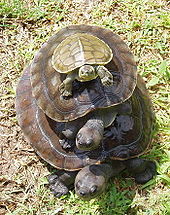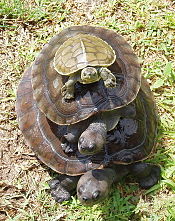Northern river terrapin
| Northern river terrapin | |
|---|---|

| |
| Scientific classification | |
| Domain: | Eukaryota |
| Kingdom: | Animalia |
| Phylum: | Chordata |
| Class: | Reptilia |
| Order: | Testudines |
| Suborder: | Cryptodira |
| Superfamily: | Testudinoidea |
| Family: | Geoemydidae |
| Genus: | Batagur |
| Species: | B. baska
|
| Binomial name | |
| Batagur baska | |
| Synonyms[3] | |
|
click to expand
| |
The northern river terrapin (Batagur baska) is a species of riverine turtle native to Southeast Asia. It has been classified as Critically Endangered on the IUCN Red List and considered extinct in much of its former range; as of 2018, the population in the wild was estimated at 100 mature individuals.[1]
Description

The northern river terrapin is one of Asia's largest freshwater and brackwater turtles, reaching a carapace length of up to 60 cm and a maximum weight of 18 kg.
The upper surface of the carapace and the soft parts are generally olive-brown, while the plastron is yellowish. Head and neck are brown with reddish bases. Males in breeding coloration have a black head and neck with a crimson or orange dorsal surface and red or orange forelegs. The colour of the pupils also changes during this period, to brown in females and yellow-white in males. During the breeding season, the color of the pupils of a female brown whereas the pupils in the males become yellowish-white.[5][6]
Distribution and habitat
The species is currently found in
Ecology
The northern river terrapin is omnivorous, taking waterside plants and small animals such as clams.[7] The species prefers freshwater habitats and moves to brackish river mouths or estuaries in the breeding season (December–March), returning after laying their eggs. Individuals have been known to undertake long seasonal migrations of 50 to 60 miles to the sand banks where they were hatched. Females usually lay three clutches of 10–34 eggs each.[7][8]
Conservation
The species is considered
A hatchery and captive breeding project was established in
Taxonomy
Two subspecies are recognized: B. b. baska (Gray, 1831) and B. b. ranongensis (Nutaphand, 1979).[2]
See also
References
- ^ . Retrieved 18 November 2021.
- ^ a b Rhodin, A. G.J.; van Dijk, P. P.; Inverson, J. B.; Shaffer, H. B.; Roger, B. (2011). "Turtles of the world, 2011 update: Annotated checklist of taxonomy, synonymy, distribution and conservation status" (PDF). Chelonian Research Monographs. 5. Archived (PDF) from the original on 2012-01-31.
- (PDF) from the original on 2011-05-01. Retrieved 29 May 2012.
- ^ "Northern River Terrapin (Batagur baska)". Turtle Survival Alliance (TSA).
- ^ a b Boulenger, G. A. (1890). The Fauna of British India, including Ceylon and Burma: Reptilia and Batrachia. Taylor & Francis.
- ^ "An endangered terrapin". The New Indian Express. Archived from the original on June 1, 2016.
- ^ a b "Batagur baska field guide". Asian Turtle Network.
- ^ "Batagur baska". Arkive.org. Archived from the original on 2015-09-05. Retrieved 2015-09-04.
- ^ a b Moll, E. O.; Kalyar Platt; Platt, S. G.; Praschag, P.; van Dijk, P. P. "Batagur baska : Northern river terrapin" (PDF). Iucn-tftsg.org. Retrieved 2022-03-24.
Further reading
- Das, Indraneil (1989). "Batagur baska in Orissya". Hamadryad: The Journal of the Madras Crocodile Bank Trust. 14 (1): 2–3.
- Gray, J.E. (1857). "Notice of some Indian tortoises (including the description of a new species presented to the British Museum by Professor Oldham)". Annals and Magazine of Natural History. 19 (2): 342–344.
External links
- Centre for Turtle Research and Conservation (archived 19 May 2007)
- Batagur baska at the Reptarium.cz Reptile Database


